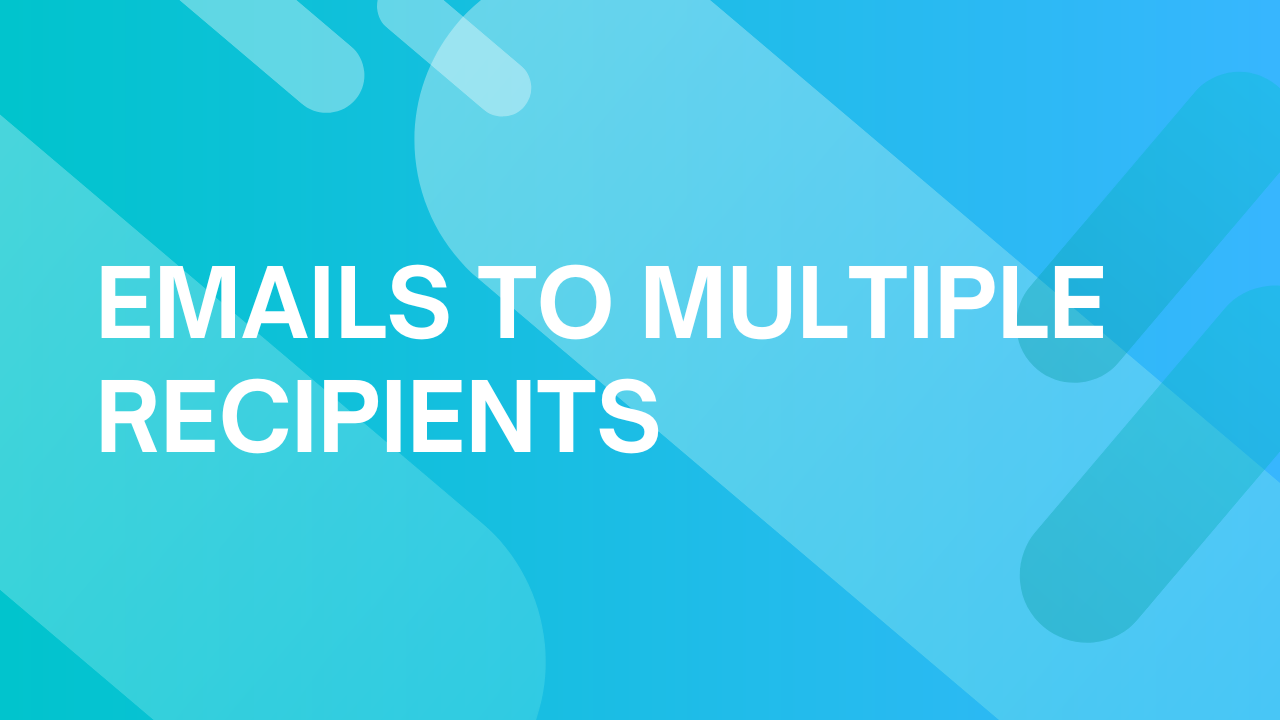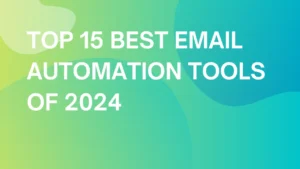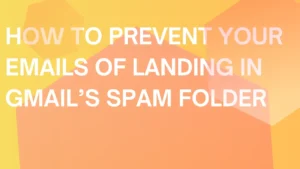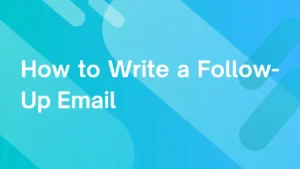
How to Send Emails to Multiple Recepients
Crafting and sending emails can feel like walking a tightrope.
On one hand, you aim for each recipient to unwrap their email like a personal note specificity tailored just for them.
On the other hand, the thought of sending out these emails one by one could eat into your time like nothing else – not to mention, it’s downright impractical.
Thankfully, there are plenty of tools and tricks available to help you broadcast your messages far and wide, all while keeping that personal touch intact.
Why send emails to multiple recipients individually?
The convenience of mass emailing, particularly through the use of the BCC (blind carbon copy) feature, often leads to several notable drawbacks that can impact your messaging’s effectiveness and professionalism.
a) The spam dilemma
One of the biggest challenges with sending emails to a lengthy list of hidden recipients (a.k.a. email blast) is the high likelihood of being flagged as spam.
This can result in error messages such as 550 high probability of spam, indicating that your email has been blocked by the recipient’s email server due to suspected spam content.
Internet Service Providers (ISPs) have gotten savvy at spotting these mass emails, and the consequences can be severe.
Not only might your intended recipients never see your message, but your IP address could also end up on a email blacklist, severely damaging your sender’s reputation in the long run.
b) A question of professionalism
Let’s face it, realizing you’re just one of many BCC’d on an email doesn’t exactly make you feel special.
This method, while practical for certain uses, falls short in formal or professional contexts.
It sends a signal that the sender might not have taken the time to consider each recipient’s unique perspective or needs.
The BCC feature, a relic of past decades, struggles to find its place in the modern, personalized world of email communication we navigate today.
c) The importance of personalization
Relying on the BCC feature puts you at a significant disadvantage.
The inability to tailor messages to each recipient means your emails might come off as bland and impersonal.
A one-size-fits-all approach is less likely to leave an impression, much less elicit a positive response.
d) The “Reply All” problem
A common problem in email communication is the dreaded “Reply all” scenario, where a single response is broadcasted to everyone on the CC list, potentially cluttering inboxes and aggravating those not interested in the conversation.
While BCC recipients are spared from this fate—replying all from a BCC’d email only addresses the original sender and those in the ‘To‘ field—it highlights the issues of mass emailing techniques for engaging in discussions or feedback.
While the allure of sending one email to many with a few keystrokes is strong, the drawbacks—ranging from increased spam risk to a lack of personalization—highlight the need for a more individualized approach.
As we navigate the complexities of digital communication, it’s clear that taking the extra time to personalize and directly address your emails can lead to more meaningful connections and professional respect.
When should you send emails to multiple recipients separately?
The decision to send emails to multiple recipients separately isn’t just about etiquette—it’s about strategy, especially when it comes to ensuring your message hits home.
Unlocking the potential of email analytics
When it comes to email campaigns, flying blind is not an option.
Platforms like Gmail and Outlook (which use BCC for mass emails) fall short of delivering the insights necessary to gauge the success of your mass emails.
Without detailed analytics—like who opens your emails, when they’re opened, and what links are clicked—you’re missing out on valuable data that could help you improve your strategy.
This is particularly critical for email marketers and sales professionals looking to improve the impact of their campaigns.
Identifying the perfect time for personalized mass mailings
Determining the optimal moment to send individualized bulk emails is a game-changer.
It sets the stage for a more meaningful interaction with your audience.
Here are some scenarios where personalizing each email can significantly improve your message’s effectiveness:
- Outreach campaigns: Tailoring emails to potential leads can increase engagement, making your pitch resonate on a personal level.
- Promotions and sales announcements: Announce your latest deals or sales with a personal touch to make each customer feel special.
- Surveys and feedback requests: Personally asking for opinions or feedback increases response rates, showing that you value each individual’s input.
- Event invitations: Personal invitations to events or meetings can increase attendance and engagement.
- Newsletters: Tailor your newsletter greetings to foster a closer connection with your subscribers.
By choosing to personalize, you’re sending a message that you’ve thought about each recipient’s unique perspective, needs, and relationship to your message.
This approach unlocks the full potential of your email communications, turning every sent email into an opportunity for engagement.
What to do before you send emails to multiple recipients
When you’re gearing up to send emails to a group, a little prep work can go a long way.
Here are two important steps to take before you unleash your email campaign into the wild.
Confirm subscription status
First things first: Ensure every recipient on your list has chosen to be there.
Whether you’re using Gmail, Outlook, or another email service, take the time to confirm that each person has subscribed to your communications.
For those not already in your address book, adding them manually is a necessary step, but one that reaffirms their interest in your messages.
Clean your email list
An up-to-date email list is your best defense against the dreaded bounce-back. Tools like EmailListVerify can help you sift through your contacts to weed out inactive, invalid, or abandoned email addresses.
A clean list means your emails are more likely to find their way to interested readers, rather than disappearing into the void of the internet or, worse, triggering spam filters.
Taking these steps also builds a foundation of trust and reliability with your recipients.
By ensuring each contact has opted in and maintaining a clean, engaged list, you’re setting the stage for more meaningful connections and a more successful email strategy.
Warm up your email account
You can’t really start sending emails in large numbers unless you have properly warmed up your email account.
ESPs (Email Server Providers) and ISPs (Internet Service Providers) pay attention to the reputation of the inbox that is sending messages on a large scale – if the account appears to be spammy, its messages might not land into recipients’ inboxes or it may end up on some email blacklist.
In order to avoid this issue, you can utilize tools like Warmup Inbox – a simple email warm-up service that can automatically prepare your inboxes before launching any large email campaign.
With Warmup Inbox, you can gradually warm up your email account over time (and keep it warm even in the future), monitor your email and domain reputation as well as keep avoid email spam folders and blacklist altogether.
You can try our Warmup Inbox tool completely for FREE
(no credit card needed).
Ways to send emails to multiple recipients
Efficiently reaching out to multiple recipients without compromising on personalization or facing spam filters is a fine art.
From leveraging the built-in features of popular email clients like Gmail and Outlook to exploring sophisticated email automation platforms, these how-tos and best practices for mass email communication can help you get started on the right foot.
Automation tools to use
Navigating the vast sea of email automation tools can be daunting, especially when you’re looking for the perfect balance between functionality, user-friendliness, and cost-effectiveness.
Here are our four top picks for tools to help you automate your email sending.
1. Mailchimp

Mailchimp is well-known for its simplicity and comprehensive feature set.
With its drag-and-drop email builder, extensive template library, and deep analytics, it’s a fantastic tool for anyone looking to start or scale their email marketing efforts.
Its ability to segment lists and personalize emails helps in sending targeted communications that resonate with the audience.
2. MailerLite

MailerLite puts an emphasis on simplicity and elegance.
This tool offers a clean interface and straightforward functionality, making email marketing accessible to beginners and professionals alike.
Its features include an intuitive drag-and-drop editor, detailed campaign reports, and advanced segmentation options.
3. Zoho Campaigns

Zoho Campaigns integrates into the wider Zoho ecosystem, offering a great solution for those already using Zoho’s suite of products.
It specializes in automating email sequences, tracking recipient behavior, and customizing emails based on interactions.
With a rich set of pre-designed templates and real-time analytics, Zoho Campaigns makes it easy to refine targeting and engagement strategies that match your business’s objectives.
4. Drip

Drip puts a focus on e-commerce businesses, providing sophisticated automation workflows that drive sales through personalized email campaigns.
This platform excels at customer segmentation, behavioral-based email triggering, and comprehensive performance analysis.
Drip’s powerful e-commerce CRM features allow online retailers to create a highly personalized shopping experience, increasing customer loyalty and boosting revenue.
How to send emails to multiple recipients separately using Gmail
While Gmail is a staple in personal and professional communication, its BCC feature allows for mass emailing with a caveat – it lacks the finesse of a personalized message.
Here’s how to navigate Gmail for mass sends:
- Compose: Start by clicking “Compose” in Gmail to open a new email.
- Craft your message: Fill in your subject line and email body.
- Address your email: Place the main recipient’s email in the “To” field. Use the “BCC” field for other recipients to keep their addresses hidden. Click “BCC” to add multiple hidden recipients.
- Send off: After double-checking your content and recipient list, hit “Send” to dispatch your email to the group.
| Tip: If you type Undisclosed recipients <[email protected]> (your email) in the “To” field, it won’t show to the recipients. This is better than just typing your own email ID as the main recipient, as it might feel a little strange and unprofessional to do so. |
How to send emails to multiple recipients separately using Outlook
Outlook offers another avenue for reaching multiple recipients discreetly:
- Start a new email: Log into Outlook and click “New Email“. Activate the “BCC” option under the “Options” tab to make the BCC field visible.
- Address your email: Enter the primary recipient in the “To” field and add hidden recipients in the “BCC” field. Separate multiple addresses with commas or semicolons.
- Finalize and send: After composing your message, click “Send” to distribute your email.
Conclusion
The journey from crafting your message to choosing the right tool for distribution is integral to the effectiveness of your communication strategy.
Remember, the ultimate goal is to connect genuinely and meaningfully with each recipient.
With the right tools, you’re well on your way to creating email campaigns that resonate deeply, foster loyalty, and drive action.
Just make sure you put these insights into practice to transform the way you communicate with your audience.



